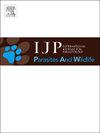Intestinal parasites infecting free-ranging primates in Colombia: Morphological and molecular evidence
IF 2.2
3区 医学
Q3 ECOLOGY
International Journal for Parasitology-Parasites and Wildlife
Pub Date : 2025-02-08
DOI:10.1016/j.ijppaw.2025.101047
引用次数: 0
Abstract
Intestinal protozoan and metazoan parasites of public health concern have been found infecting non-human primates (NHPs). Since zoonotic parasite transmission can be linked to ecosystem transformation due to close contact between human and NHPs, this study aimed to morphologically identify intestinal parasites infecting NHPs living in seven forest fragments in Colombia and to molecularly characterise selected parasite taxa of zoonotic interest (Giardia sp. and Ascaris sp.). Building on and updating previous parasite surveys on free-ranging platyrrhines, 212 faecal samples were collected from wild Alouatta seniculus, Ateles hybridus, Aotus griseimembra, Cebus versicolor, Saimiri cassiquiarensis, and Sapajus apella. Flotation and faecal smears were performed in order to identify parasites based on morphological characteristics. Samples microscopically classified as positive for Giardia sp. and Ascaris sp. were then processed for molecular characterisation. Amplification of the triosephosphate isomerase (TPI) and the 18S genes was done for Giardia sp., while for Ascaris sp. a PCR-RPLF of the entire ITS region was carried out. About 96% of the samples were positive for intestinal parasites, including: protozoans (Blastocystis sp., Balantidium sp., Dientamoeba fragilis-like, Entamoeba sp., Giardia sp., Eimeria sp.), nematodes (Ascaris sp., strongyliform larvae, Trypanoxyuris sp., Ancylostomatidae), trematodes (Controrchis sp., Trematoda), cestodes (Hymenolepis sp., Cestoda), and acanthocephalans. By microscopy, the prevalence of Giardia sp. and Ascaris sp. was 16.5% and 0.9%, respectively. Later on, Giardia duodenalis (Assemblages A and B) and Ascaris lumbricoides were identified through molecular techniques. This study provides new information of intestinal parasites infecting free-ranging NHPs exposed to anthropogenic disturbance. The finding of parasites with zoonotic potential suggests epidemiological implications in NHP conservation and human health, at the human-NHP interface.

哥伦比亚自由放养灵长类感染肠道寄生虫:形态学和分子证据
已发现非人类灵长类动物(NHPs)感染引起公共卫生关注的肠道原生动物和后生动物寄生虫。由于人畜共患寄生虫的传播可能与人类与NHPs之间的密切接触而导致的生态系统转变有关,因此本研究旨在从形态学上鉴定生活在哥伦比亚7个森林片段中感染NHPs的肠道寄生虫,并对选定的人畜共患寄生虫分类群(贾第鞭毛虫和蛔虫)进行分子表征。在以往对自由放养的白颈天牛进行寄生虫调查的基础上,收集了野生白颈天牛、杂花天牛、灰腹天牛、花斑天牛、黑尾天牛和无鳞天牛212份粪便样本。为了根据形态特征鉴定寄生虫,进行了浮选和粪便涂片。经显微镜鉴定为贾第鞭毛虫和蛔虫阳性的样品随后被处理以进行分子鉴定。贾第鞭毛虫的三磷酸异构酶(TPI)和18S基因扩增,蛔虫的整个ITS区域进行了PCR-RPLF扩增。肠道寄生虫检出阳性率约96%,包括原生动物(囊虫、Balantidium、脆弱样地阿米巴、内阿米巴、贾第鞭毛虫、艾美耳虫)、线虫(蛔虫、强棒状幼虫、锥虫、钩虫科)、吸虫(收缩虫、吸虫)、囊虫(膜孔虫、囊虫)、棘头虫等。显微镜下贾第鞭毛虫和蛔虫的感染率分别为16.5%和0.9%。随后,利用分子技术鉴定了十二指肠贾第虫(组合A和B)和类蚓蛔虫。本研究提供了受人为干扰的自由放养NHPs感染肠道寄生虫的新信息。具有人畜共患潜力的寄生虫的发现表明,在人类与新冠肺炎的交界面,对新冠肺炎的保护和人类健康具有流行病学意义。
本文章由计算机程序翻译,如有差异,请以英文原文为准。
求助全文
约1分钟内获得全文
求助全文
来源期刊

International Journal for Parasitology-Parasites and Wildlife
Medicine-Infectious Diseases
CiteScore
3.80
自引率
5.60%
发文量
113
审稿时长
45 days
期刊介绍:
The International Journal for Parasitology: Parasites and Wildlife (IJP-PAW) publishes the results of original research on parasites of all wildlife, invertebrate and vertebrate. This includes free-ranging, wild populations, as well as captive wildlife, semi-domesticated species (e.g. reindeer) and farmed populations of recently domesticated or wild-captured species (e.g. cultured fishes). Articles on all aspects of wildlife parasitology are welcomed including taxonomy, biodiversity and distribution, ecology and epidemiology, population biology and host-parasite relationships. The impact of parasites on the health and conservation of wildlife is seen as an important area covered by the journal especially the potential role of environmental factors, for example climate. Also important to the journal is ''one health'' and the nature of interactions between wildlife, people and domestic animals, including disease emergence and zoonoses.
 求助内容:
求助内容: 应助结果提醒方式:
应助结果提醒方式:


